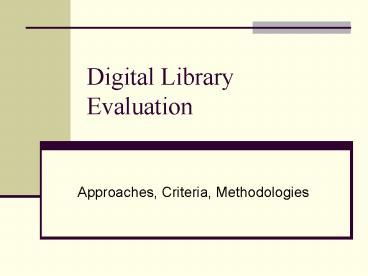Digital Library Evaluation PowerPoint PPT Presentation
1 / 26
Title: Digital Library Evaluation
1
Digital Library Evaluation
- Approaches, Criteria, Methodologies
2
Definition of the term evaluation
- Means assessing performance or value of a
system, process (technique, procedure ..),
product or policy. (Saracevic, 1995) - The process of identifying and collecting data
about specific services or activities,
establishing criteria by which their success can
be assessed, and determining both the quality of
the service or activity and the degree to which
the service or activity accomplishes stated goals
and objectives. ( Harter and Hert, 1997)
3
What is DL evaluation?
- Marchionini (2000) believes that evaluating
digital libraries is a bit like judging the
success of a marriage where much depends on how
successful the partners are as individuals as
well as the emergent conditions made possible by
the union.
4
Evaluation as research vs. product evaluation ?
- It is important to distinguish evaluation as a
research process from evaluation in the product
testing and system efficiency sense. - However, evaluation research considers the
interactions of complex phenomena including
people and reaches conclusions through chains of
inferences supported by data rather than direct
measurement.
5
Why is DL evaluation important?
- Digital libraries need to be evaluated as systems
and as services to determine how useful, usable,
and economical they are. - Results of evaluation studies can provide
strategic guidance for the design and deployment
of future systems
6
Digital library evaluation literature
- Two general types
- Literature on concepts, metrics, models and
approaches or methodologies - Literature that reports evaluative studies and
provides qualitative and/or quantitative data
7
Various approaches and contexts
- Digital libraries are multifaceted,
multidimensional social, technical, cultural and
institutional systems and as a result have been
evaluated from a wide range of perspectives. - Context of evaluation system-centred, human
centred, usability-centred, ethnographic approach
8
Evaluation approaches
- Information retrieval (TREC)
- HCI usability testing
- Human-centred information needs and search
behaviour, user interaction with information
9
Elements for the evaluation of DLs
- Digital collections
- Selection, gathering, holdings
- Organization, structure, storage
- Interpretation, representation, metadata
- Management
- Preservation and persistence
- Access
- Physical networks
- Interfaces, interaction
- Search, retrieval
- Services
- Availability
- Assistance and referral
- Use, users, communities
- Security, privacy, policies, legal aspects
- Staff and operations
- Costs and economics
- Integration, cooperation with other resources,
libraries and services
Saracevic, 2000
10
Types of evaluation
- Formative evaluation begins at the initial
stages of a development project to establish
baselines on current operations, set goals, and
determine desired outcomes. - Summative evaluation takes place at the end of a
project to determine if the intended goals were
met. - Iterative evaluation takes place throughout a
project, beginning in the earliest design and
development stages. - Comparative evaluation requires standardized
measures that can be compared across systems.
Communities can identify and validate measures.
11
DL evaluation criteria (Saracevic, 2004)
- Usability content, format, process, overall
satisfaction - System features system performance such as
response time, functionality, algorithm
performance - Usage usage patterns, usage statistics, use of
materials, what uses for what purposes - Ethnographic and other criteria anthropological,
cultural, linguistic and impact implications and
issues
12
Xie, H. I. (2006). Evaluation of digital
libraries Criteria and problems from users'
perspectives. Library Information Science
Research, 28(3), 433-452.
13
Methodology
- surveys, including direct questionnaires and
online surveys - focus groups and structured interviews
- observations
- case studies
- records and usage analysis
- documents, meeting, communication analysis
(anthropology) - economic analysis
- transaction log analyses
- think aloud, cognitive walk-through
- eye tracking
14
Examples of evaluation studies
- Perseus Digital library
- Usability inspection of NCSTRL
- Usability study of digital libraries ACM,
IEEE-CS, NCSTRL,NDLTD
15
Perseus Digital libraryEvaluation goals
- Access to large volumes of multiple media source
- Freedom self-directed access and use,
- Collaboration among learners and teachers.
16
Preseus DL Evaluation objects and data
collection methods
- Evaluation objects
- Learners,
- Teachers,
- The technical system,
- The content
- Data collection methods
- Observations,
- Interviews,
- Document analysis,
- Learning analysis.
17
Usability inspection of NCSTRL
- Three evaluators one fully familiar, one new to
NCSTRL and one expert in the general area of
digital libraries - Co-discovery technique
- Task-driven
- Simple and advanced search facilities, browsing,
submit reports
Hartson et al. (2004)
18
NCSTRL Usability inspection results
- Problems with consistency the terms Group and
archives were used interchangeably to
institutions and collections belonging to
institutions - Problems with wording Discovery date, Submit
to CoRR - The term hit rather than more descriptive terms
- Tabs look like buttons but do not behave like
buttons - No user control of result display
- No query refinement facility
- The browsing option is only available by
institution not author, title etc.
19
Usability study of digital libraries ACM,
IEEE-CS,NCSTRL,NDLTD
- Four digital libraries
- Four tasks for each library
- 48 computer science students
- Video camera, screen capture, search logs
- Evaluation criteria search features, search
time, search errors
(Kengeri et al. 1999)
20
(No Transcript)
21
Selected results
- Some users commented that the search interfaces
were too complicated and distracting. - ACM digital library provided too many search
options. - Users wanted to search by keyword, author, or
title, and where appropriate by year, journal,
and volume. - NDLTD online instructions were not easy to
understand - In NDLTD the difference between search and browse
was not obvious
22
Eye tracking study
- Using eye tracking to evaluate alternative search
results interfaces (Rele Duchowski, 2005) - Eye movements and ocular behaviour
- fixations
- saccades
- pupil dilation
- scan paths
23
Eye trackers
24
(No Transcript)
25
(No Transcript)
26
p

